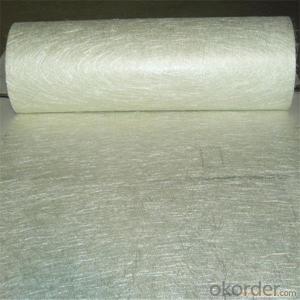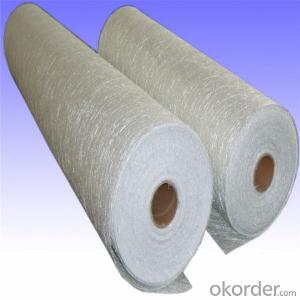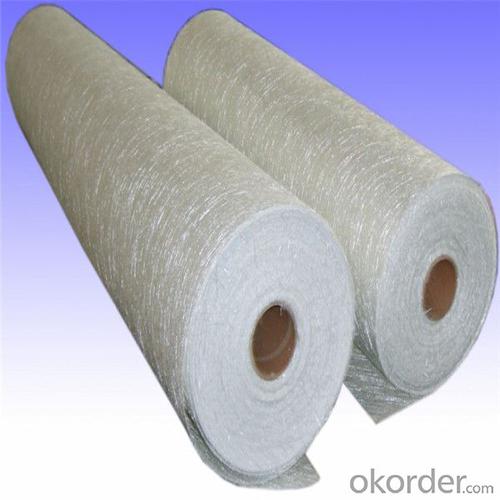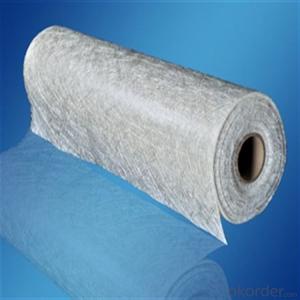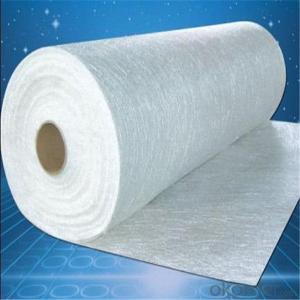Fiberglass Chopped Strands Stand Mat for Pp Panel Factory
- Loading Port:
- Tianjin
- Payment Terms:
- TT OR LC
- Min Order Qty:
- 100 m.t.
- Supply Capability:
- 20000 m.t./month
OKorder Service Pledge
Quality Product, Order Online Tracking, Timely Delivery
OKorder Financial Service
Credit Rating, Credit Services, Credit Purchasing
You Might Also Like
Quick Details
| Technique: | Chopped Strand Fiberglass Mat (CSM) | Dimensions: | 450gsm | Mat Type: | Continuous Filament Mat |
| Fiberglass Type: | E-Glass | Softness: | softness | Place of Origin: | Jiangxi, China (Mainland) |
| Brand Name: | cnbm | Model Number: | 450gsm | color: | white |
| fiberglass type: | E glass | product: | e-glass powder chopped stand mats | binder: | powder or emulsion |
| width: | 1040 or 1270mm, as your requirement | weight: | 30 or 45kg/roll | paper tube diameter: | 90mm |
| outer diameter of roll: | 256mm | packing: | plastic film+carton box + pallet |
Packaging & Delivery
| Packaging Details: | plastic film+carton box + pallet |
| Delivery Detail: | 15-20days |
Specifications
1.e-glass powder chopped stand mats
2.binder:power or emulsion
3.width:1040mm or 1270mm
4.weight:450gsm
Picture

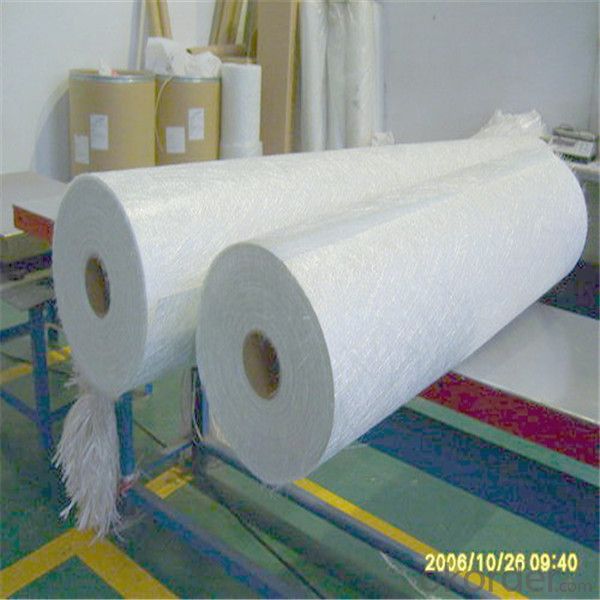




- Q: Is fiberglass chopped strand suitable for applications requiring high weather resistance?
- When it comes to high weather resistance, fiberglass chopped strand isn't the best choice. Although fiberglass is known for being strong and durable, chopped strand fiberglass lacks the necessary qualities to withstand harsh weather conditions for an extended period of time. Chopped strand fiberglass is commonly used in applications where mechanical strength is the main requirement, such as automotive parts, pipes, and boat hulls. However, it isn't designed to handle UV radiation, extreme temperature changes, or prolonged exposure to moisture and chemicals. If you need a material that can withstand harsh weather conditions, it's better to consider other options like reinforced plastics, specialty coatings, or composites with enhanced weatherability properties. These materials are specifically engineered to endure sunlight, temperature fluctuations, and moisture, ensuring long-lasting durability and performance in outdoor environments. To ensure high weather resistance, it's important to evaluate the specific requirements of your application and seek advice from experts or manufacturers. They can help determine the most suitable materials to achieve the level of weather resistance you need.
- Q: Can fiberglass chopped strand be used in the production of aerospace interiors?
- Yes, fiberglass chopped strand can be used in the production of aerospace interiors. It is commonly used in applications such as insulation, paneling, and reinforcement for lightweight structures.
- Q: How to make glass fiber mould
- Roving can be directly used for some composite molding methods, such as winding, pultrusion process, because of its uniform tension, can also be woven roving fabric, in certain applications will also be further chopped rovings.
- Q: What are the different sizes available for fiberglass chopped strand?
- Fiberglass chopped strand comes in a variety of sizes to meet different needs and specifications. The typical sizes for fiberglass chopped strand include 1/8 inch (3 mm), 1/4 inch (6 mm), and 1/2 inch (12 mm), which refer to the length of the fibers that have been cut. The choice of size depends on the specific requirements of the project at hand. Smaller sizes are often used when a smoother finish is desired or when working with thinner materials. They are also well-suited for applications like resin transfer molding (RTM) and vacuum infusion processes. On the other hand, larger sizes are commonly employed in applications that call for increased strength and reinforcement, such as in the production of fiberglass-reinforced plastics (FRP), composites, and concrete. It is crucial to select the correct size of fiberglass chopped strand based on the project's requirements, desired mechanical properties, and the manufacturing process being utilized. Seeking guidance from a supplier or an expert in the field can assist in determining the most appropriate size for a particular application.
- Q: What are the typical electrical insulation properties of chopped strand composites?
- Chopped strand composites are known for their exceptional electrical insulation properties. The inclusion of reinforcing fibers, such as fiberglass or carbon fibers, gives these composites a high dielectric strength, enabling them to withstand high voltages without experiencing electrical breakdown. The fibers act as obstacles, blocking the flow of electric current through the material. In addition, chopped strand composites exhibit a low electrical conductivity. This characteristic is particularly important in situations where electrical insulation is necessary to prevent electrical short circuits or leakage currents. The composite matrix, typically composed of a polymer resin, effectively insulates the reinforcing fibers and reduces their electrical conductivity. Furthermore, chopped strand composites possess excellent resistance to moisture and chemicals. This resistance is crucial in electrical applications that are exposed to harsh environments or substances that could degrade the insulation properties. Moisture and chemicals have the potential to compromise the electrical insulation capabilities of materials, leading to possible electrical failures. However, chopped strand composites serve as a dependable barrier against these harmful factors. In conclusion, the combination of high dielectric strength, low electrical conductivity, and resistance to moisture and chemicals make chopped strand composites an ideal choice for a variety of electrical insulation applications. These properties ensure the safety and reliability of electrical systems, preventing electrical failures and facilitating the efficient flow of electricity.
- Q: Can fiberglass chopped strand be used in aerospace interior components?
- Yes, fiberglass chopped strand can be used in aerospace interior components. Fiberglass is a lightweight and versatile material that offers excellent strength and durability. It is commonly used in various industries, including aerospace, for its high-performance properties. In aerospace, interior components often require materials that are lightweight yet strong enough to withstand the demanding conditions of flight. Fiberglass chopped strand meets these requirements as it is lightweight and has high tensile strength. It can be used in the manufacturing of interior components such as panels, seat backs, overhead bins, and cabin partitions. Additionally, fiberglass chopped strand offers excellent fire resistance properties, which is crucial for aerospace applications. It can meet the stringent fire safety regulations and requirements set by aviation authorities. Furthermore, fiberglass chopped strand is relatively easy to process, allowing for efficient and cost-effective manufacturing processes. It can be molded into various shapes and sizes, making it suitable for complex aerospace interior designs. Overall, fiberglass chopped strand is a suitable material for aerospace interior components due to its lightweight, high strength, fire resistance, and ease of processing. Its use in the aerospace industry helps to ensure the safety, performance, and comfort of passengers and crew members during flight.
- Q: What are the thermal insulation properties of fiberglass chopped strand?
- Fiberglass chopped strand has excellent thermal insulation properties due to its low thermal conductivity and high resistance to heat transfer. It effectively traps air pockets within its structure, which helps to reduce heat flow and maintain thermal stability. Additionally, its composition of glass fibers provides good insulation against both high and low temperatures, making it a popular choice for applications requiring thermal insulation.
- Q: How does the fiber orientation impact the properties of chopped strand composites?
- The fiber orientation in chopped strand composites has a significant impact on their properties. Chopped strand composites are typically made by randomly dispersing short fibers in a matrix material. The orientation of these fibers can greatly affect the mechanical properties, such as strength, stiffness, and impact resistance, as well as the overall performance of the composite material. In a chopped strand composite, the fiber orientation determines the load-bearing capability of the material. Fibers aligned in the direction of the applied load will bear most of the stress, leading to improved strength and stiffness in that direction. On the other hand, fibers oriented perpendicular to the load will have limited load-bearing capacity, resulting in weaker properties in that direction. Moreover, the fiber orientation also influences the anisotropic behavior of the composite. Anisotropic materials have different properties in different directions, and the degree of anisotropy is determined by the fiber orientation. For instance, if the fibers are randomly oriented, the composite will exhibit more isotropic behavior, meaning the properties will be relatively similar in all directions. However, if the fibers are aligned, the composite will be more anisotropic, with properties varying significantly based on the direction of loading. The impact resistance of chopped strand composites is also affected by the fiber orientation. Fibers oriented in the direction of impact can effectively absorb and distribute the energy, resulting in improved impact resistance. On the contrary, fibers oriented perpendicular to the impact direction may not be as effective in absorbing the energy, making the composite more susceptible to damage. In summary, the fiber orientation plays a crucial role in determining the properties of chopped strand composites. By controlling the alignment of the fibers, manufacturers can tailor the composites to meet specific application requirements, optimizing strength, stiffness, impact resistance, and anisotropy to enhance the overall performance of the material.
- Q: How does the fatigue resistance of the chopped strand affect its performance?
- The fatigue resistance of a chopped strand significantly affects its performance. Fatigue resistance refers to the ability of a material to withstand repeated loading and unloading cycles without experiencing a significant reduction in its mechanical properties or structural integrity. In the case of chopped strand, which is typically used as a reinforcement material in various composite applications, its fatigue resistance directly impacts the durability and reliability of the final product. When subjected to cyclic loading, such as in dynamic or high-stress environments, the chopped strand must be able to withstand the repetitive stress without undergoing excessive deformation, degradation, or failure. A chopped strand with high fatigue resistance will exhibit enhanced performance characteristics compared to a material with lower fatigue resistance. It will be able to endure a greater number of loading cycles before showing signs of mechanical deterioration, such as cracking, delamination, or loss of stiffness. The fatigue resistance of chopped strand is influenced by several factors, including the type and quality of the fibers used, the manufacturing process, and the composite matrix material. Fibers with higher tensile strength, such as carbon or aramid fibers, generally exhibit better fatigue resistance compared to lower strength fibers like glass. Furthermore, the manufacturing process, such as the alignment and distribution of the chopped strands within the composite, can impact fatigue resistance. Properly aligned and evenly distributed strands can distribute the applied load more uniformly, reducing stress concentrations and enhancing fatigue resistance. The composite matrix material also plays a role in fatigue resistance. The matrix should have good adhesion and compatibility with the chopped strand to ensure efficient load transfer and minimize the development of micro-cracks or fiber/matrix interface failures during cyclic loading. In summary, the fatigue resistance of chopped strand is a critical consideration in determining its performance. Higher fatigue resistance leads to improved durability, longer service life, and overall better performance in dynamic or high-stress applications. Therefore, it is essential to select chopped strand materials with suitable fatigue resistance properties for specific applications to ensure reliable and long-lasting composite products.
- Q: How does the density of the chopped strand affect its performance?
- The density of the chopped strand plays a significant role in determining its performance. Chopped strands are commonly used as reinforcement in composite materials, such as fiberglass, to improve their strength and mechanical properties. When the density of the chopped strand is high, meaning a larger number of strands per unit volume, the resulting composite material tends to exhibit enhanced mechanical properties. This is primarily because a higher density of strands provides more surface area for interaction with the matrix material, resulting in improved load transfer and distribution throughout the composite structure. As a result, the composite becomes stronger and more resistant to deformation and fracture. On the other hand, a lower density of chopped strand can lead to a decrease in the performance of the composite. With fewer strands present, there is less opportunity for load transfer and distribution, which can result in reduced strength and stiffness. Additionally, a lower density of chopped strand may result in the formation of voids or gaps within the composite, compromising its overall integrity and mechanical properties. It is important to note that the optimal density of chopped strand depends on various factors, including the specific application and desired performance requirements. Different applications may require different densities to achieve the desired balance between strength, stiffness, and other mechanical properties. In conclusion, the density of chopped strand significantly affects its performance in composite materials. A higher density generally improves the mechanical properties of the composite, while a lower density can lead to decreased performance. The appropriate density of chopped strand should be carefully considered based on the specific application and desired performance requirements.
Send your message to us
Fiberglass Chopped Strands Stand Mat for Pp Panel Factory
- Loading Port:
- Tianjin
- Payment Terms:
- TT OR LC
- Min Order Qty:
- 100 m.t.
- Supply Capability:
- 20000 m.t./month
OKorder Service Pledge
Quality Product, Order Online Tracking, Timely Delivery
OKorder Financial Service
Credit Rating, Credit Services, Credit Purchasing
Similar products
Hot products
Hot Searches
Related keywords
